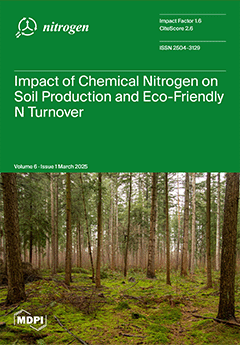Nitrogen fertilization greatly affects the development of sugar beet leaf and photosynthetic activity. This study aimed to evaluate the dynamics of leaf SPAD index, chlorophyll a (
Chl a), chlorophyll b (
Chl b), carotenoids (
Caro), and the macronutrient status (N, P, K, Na, Mg) in different N fertilization rates in sugar beet production. This study set up a two-year field experiment in Eastern Croatia. The N fertilization rate was applied as: N0—control, N1—only presowing fertilization (45 kg/ha), and N2—presowing with topdressing (99 kg/ha in 2014 and 85.5 kg/ha in 2015). In general, N fertilization has a significant (
p ≤ 0.05) influence on leaf pigments, except for
Chl b. With the highest N dose (N2), the
Chl content in the leaves increased by 12% compared to the control treatment (0.75 mg/g FW). The
Caro dynamics in the leaves of vegetative growth were significantly different (
p ≤ 0.05); leaves in the younger growth stage at the end of May had the highest
Caro content (0.011 mg/g FW). In general, the SPAD index was significantly different (
p ≤ 0.05), among N fertilization, whereas the lowest SPAD was found at the control treatment (38.7) and the highest at the N2 treatment (40.8). In general, regarding nitrogen fertilization, the lowest SPAD readings had sugar beet leaves at the control treatment (38.7), whereas the highest was determined at the N2 treatment (40.8). A strong positive relationship (
p ≤ 0.01) was determined for
Chl a,
Chl b,
Chl a +
b, and
Chl a +
b/
Caro with the SPAD index, whereas an inverse relationship with the SPAD index was determined for
Caro and
Chl a/
b. The results demonstrate that nitrogen application, particularly at higher rates, positively influences chlorophyll and carotenoid content, as well as overall plant health, which can inform agricultural practices for more sustainable and efficient sugar beet cultivation.
Full article





